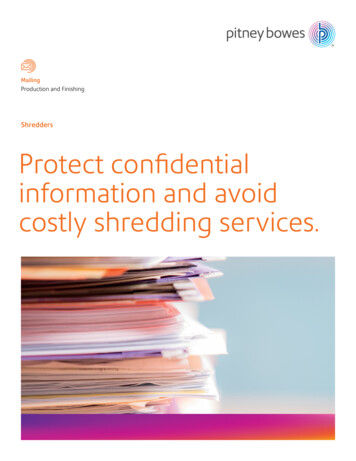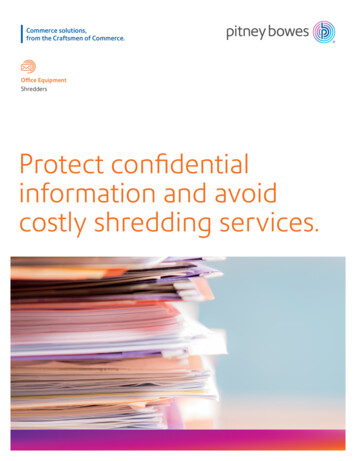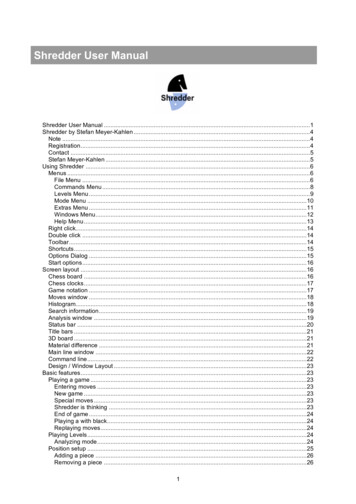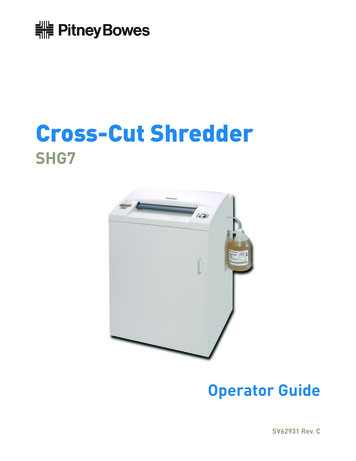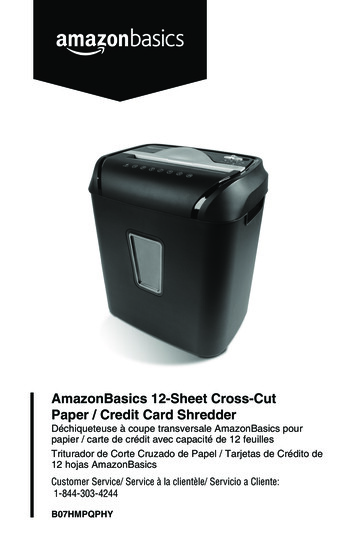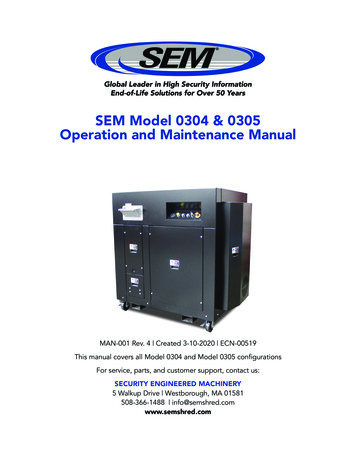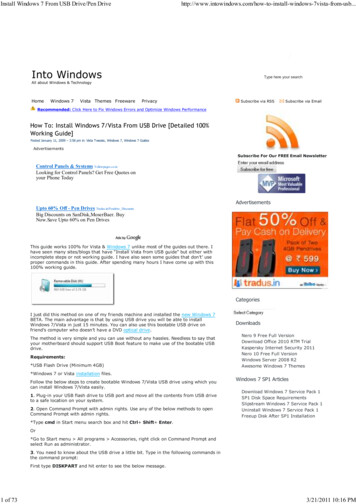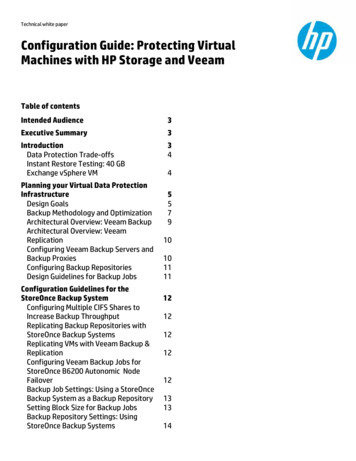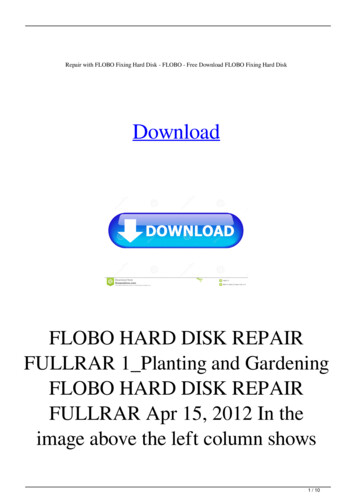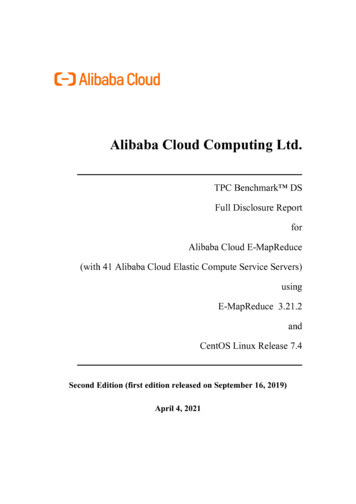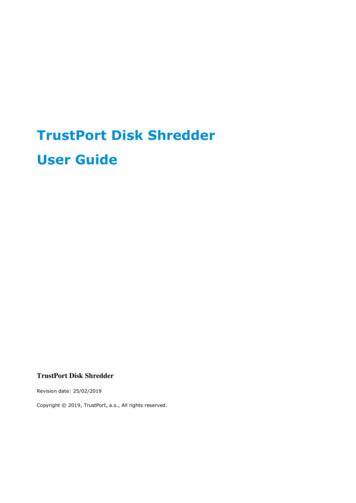
Transcription
TrustPort Disk ShredderUser GuideTrustPort Disk ShredderRevision date: 25/02/2019Copyright 2019, TrustPort, a.s., All rights reserved.
ContentCONTENT . 21 TRUSTPORT DISK SHREDDER . 31.1PRODUCT OVERVIEW AND KEY FEATURES . 31.2MINIMUM SYSTEM REQUIREMENTS. 32 TRUSTPORT DISK SHREDDER SERVER . 42.1MAIN MENU ITEMS . 42.2USER ROLES . 62.3LICENSES . 62.4CERTIFICATES . 73 PREPARING OF BOOTABLE SHREDDING USB OR DVD . 84 SHREDDING PROCESS WITH BOOTABLE USB OR DVD . 94.1CONNECTION SETTINGS TAB . 104.2USER AUTHENTICATION TAB . 114.3OPERATIONAL MODE TAB . 124.4DISK SELECTION TAB . 124.5SECURE ERASE METHOD TAB . 134.6PRE-REPORT TAB . 144.7ERASING TAB . 154.8FINISH POST-REPORT TAB . 155 OFFLINE SHREDDING AND CREATING OF REPORTS . 166 MODIFICATION OF DEFAULT CONFIGURATION . 187 TECHNICAL SUPPORT . 202
1 TrustPort Disk Shredder1.1 Product overview and key featuresTrustPort Disk Shredder is an application aimed for secure and effective data erasure in the enterprisenetworks as well as for use in a small office.Architecture of the Disk Shredder product consists of client side application, distributed together withbootable media (USB drive, DVD) and TrustPort Disk Shredder Server – local or in cloud - that communicatewith TrustPort Disk Shredder Client. Communication between this to components enables client part to verifylicense validity, send information about the shredding processes running at local hosts and enables remotelyconfigure and control shredding at an end-point computer. There’s available simultaneous erase of multipledrives either connected locally or via remote erasure through the TrustPort Disk Shredder Server.Disk Shredder Client is not installable application. User needs to boot from received USB or DVD media withthe Disk Shredder bootable image prepared by an administrator in the TrustPort Disk Shredder Server.Disk ShredderClient bootedfrom DVDDisk ShredderServerAuthentication, License checking, Information about shredding process, reports sending .1.2 Minimum System RequirementsThe TrustPort Disk Shredder Server installation requires at least the following hardware configuration: CPU with 2 cores. 1 GB RAM. 20 GB of hard disk space.The TrustPort Disk Shredder Client require for running computer: 256 MB RAM.USB or CD/DVD drive.Ethernet NIC or Wi-Fi (not necessary for offline mode).An application is independent on the operating system of the shredded host computer.3
2 TrustPort Disk Shredder ServerTrustPort Disk Shredder Server is available via browser at IP address or via DNS name if DNS recordwas created. For example: https://shredder-demo.trustport.com/ or https://10.55.41.2 for cloudinstallation.2.1 Main Menu Dashboard - shows administrator all information about erased devices, data and failures if any. Reports – a list of all shredding reports, even failed/not finished ones. Every record includes atechnical information about a shredded device (CPU, RAM, Drives.), and a status of shreddingprocess. A real-time status information is available if a shredding process is just running.It also includes full PDF reports available for download. PDF is digitally signed.Report includes the Health Status of the hard disk. If S.M.A.R.T. test is OK then the status is setto PASSED, if not the status is set to FAILED!. Report includes also a number of “bad blocks”(reallocated sectors).The details for specific values of S.M.A.R.T. test or number of reallocated sectors may be foundusing bootable TrustPort Disk Shredder Client - see chapter 4.5 Secure erase method tab.Example of main part of report:4
Stats – this tab includes statistics about shredded data, devices and users. Remote control – tab includes a list of pending shredding processes - all shredding processesset by “On-line - remote” method. By checking the drives and choosing option resolve theshredding process in the end machine starts. See part “Operational mode”. Download shredding ISO – an option to download an ISO file image with the end-pointshredding Client application. Deploy to USB – an information about an option how to use bootable USB drives instead ofbootable DVD. Erasing templates - in case of multiple users operating in the network, everyone may havedifferent predefined shredding settings for an “Online - remote method”. As well, for every usermay be allowed a specific Operational mode. See “Remote control” option above. Users – this tab defines user role. User’s role Administration has the rights to create and manageother user’s accounts, including a shredding licenses assigned to a specific user called Manager.This role can define Shredder users who are providing a shredding process. Certificates – this tab manages users and server’s certificates. It includes option to create acertification request and uploading the key pair into a server.5
Licenses – this tab enables Administrator to add and check a new shredding licenses. Audit log - enables Administrator to view a system records stored in the logs. This recordincludes events like shredding, editing of users settings, login attempts to the Disk ShredderServer and a similar service logs.2.2 User RolesThere are different roles defined in the Trustport Shredder Server: Administrator - can change all available settings of the TrustPort Shredder Server. He cancreate another user, confirm his certificates and see all shredding reports and statisticsgenerated by all other users. This account can be also used for a device shredding as well.Administrator has full control over a user management. Manager - can create another Shredding user and Manager can see all the reports and statisticsgenerated by these users. He can also confirm/accept their certificates. Basically, Manager issupervising the users created by him. Manager can’t see a user’s reports belonging to otherManagers (and Users created by another Mangers). This account can be also used for shreddingprocess. Shredder User - can only see his own reports. Shredder User may upload or create certificaterequest for himself. This account can be used for drive shredding. Auditor - can only view the reports and statistic. This account can’t be used for shreddingprocess.Although Administrator and Manager accounts can be fully used for shredding process, andreports generated by this role are correctly stored in server database, it is better for shreddingprocess to define user role Shredder Users. It is better for the highest level of clarity.Note: Every user may change his own settings in “My Account” option at the top right corner ofthe page appearing after login.2.3 LicensesTrustPort Shredder software licenses can be managed by Administrator. An overview of SWlicenses is available in menu Licenses in Dashboard. Any user may check the total number of anavailable and already used licenses. License is marked as used once shredding process wassuccessful finished and a report is created on the server side.6
All available licenses may be assigned to specific Mangers by Administrator, using the Addlicense button. Settings are available at a User - Licenses tab for every Manager. Theselicenses can be used by all Shredding Users created by this Manager and/or by this Manager.Note: In case, a Manager has no assigned license, the shredding process will not start!2.4 CertificatesEvery user must be authenticated before he starts a shredding process using the bootableUSB/DVD, except using the Offline mode (See chapter Shredding process with bootable USB orDVD). Depending on security settings there are two options available. Standard passwordauthentication (with login and password) and more secure certificate authentication. A selectionof allowed authentication method can be change for every user individually at Users – TrustPortDisk Shredder Client application authentication tab. By default, both options are allowed so anyuser may use a standard password authentication or a certificate authentication.In case a user wants to use certificate authentication, there must be stored user’s certificate (without need ofprivate key) at the server side - certificate can be uploaded by user itself (in tab my Account settings) or by hisManager or by an Administrator - in .PEM or .DER format (as a file with extension .PEM, .DER). On a bootableUSB drive with TrustPort Disk Shredder Client, there must be stored user’s private key in .PEM or .PFX format.7
In process of certificate generation, a user may also create certification request for certification authority, toobtain verified certificate for his private key.Every uploaded certificate must be verified for using in TrustPort Shredder Server by Administrator first or byuser Manager at a Certificate tab. Without it, user failed to login using certificate method.3Preparing of bootable shredding USB or DVDA bootable DVD (containing ISO image with TrustPort Disk Shredder Client application) may be anytimedownloaded at the left panel of TrustPort Disk Shredder Server in tab “Download shredding ISO”. ISO may beburned to physical DVD media or use as is in virtual environment (Virtual Box, VMware).As well the bootable ISO image containing the TrustPort Disk Shredder Client may be used by placing into USBdrive by using 3rd application for example “Rufus”.1) Download the ISO image from a Dashboard of TrustPort Disk Shredder Server - „Download shredding ISO“.2) Download and run Rufus application from https://rufus.akeo.ie/ (supported operating systems: Windows XP orlater Windows OS, 32 or 64 bit).8
3) Plug your USB into the PC and run Rufus, and as a “device” choose your USB flash drive. Use option “Create abootable disk using ISO Image” and browse for downloaded ISO image from point 1. Then choose Start option.Operation takes several minutes depending on the speed of your USB flash drive.As an option it is possible to use e.g. UNetbootin from https://unetbootin.github.io/ (supported operatingsystems: Windows, Linux and Mac OS X) or similar application.4Shredding process with bootable USB or DVDTo use TrustPort Disk Shredder Client there is a need to use bootable DVD (see chapter 3). The booting menuoption is generally available during startup of computer by pressing key F12 (or Esc, F2 in some cases - itdepends on the hardware manufacturer). In a BIOS menu should be available booting option DVD or USB if suchdevice is available.The second option is to change a booting sequence in the BIOS. BIOS is available during startup by pressing keyF2 (or Del, Esc, F12 in some cases, it depends on the hardware manufacturer). By moving for instance DVD tothe top of the list, you may change booting device order.9
Whenever a computer is booted from a USB or DVD media, and running the TrustPort Disk Shredder Client, asdescribed the first step, user is prompted to connect to TrustPort Disk Shredder Server to authenticate himself,and to receive shredding policy from TrustPort Disk Shredder Server. Following step is to select a shreddedmedia and, finally, when the shredding process finishes, TrustPort Disk Shredder Client sends shredding report tothe TrustPort Disk Shredder Server.In the right pane of graphical user interface are placed configuration options like language selection.In the left pane of the graphical user interface there are tabs defining functionality of the TrustPort Disk ShredderClient. Explanation of the tabs follows in next chapters.4.1 Connection settings tabUser can setup network connection settings in the tab “Connection settings” of the TrustPort Disk ShredderClient. All items are predefined and in general, it’s not necessary to change something, then can usercontinue clicking on “Connect” button. Connection settings – a user is able setup the address and port number of the TrustPort DiskShredder Server. The address can be in name convention as a host name (e.g. shredderdemo.trustport.com) or standard IP network address (e.g. 10.50.16.24). The communication portis optional, implicitly there is used port number 443. If the license allows it, fully offline mode canbe used using option “Skip to offline mode”.10
Local connection settings - setup of network connection of the local computer on which theTrustPort Disk Shredder Client is running. It is possible to choose between classical wired oroptionally wireless (Wi-Fi) connection.Common wired connection name starts by default with letters “en” (en stands for Ethernet forexample enp0s3 - Ethernet, pci bus 0, slot3).Common wireless connections name starts by default with letters “wl” (for example wlp2s0).If userchooses wireless connection, all available networks are listed in network list. DHCP servers are preset, so in most networks there’s no need to change something and continue clicking on button“Connect”. IP address - selects an interface IP address for communication with TrustPort Disk ShredderServer, for which the Local connection settings will be applied. Automatic DHCP method is used bydefault. DNS - setup of a DNS server can be done either automatically with help of a DHCP server in thenetwork or manually by defining it’s IP address or host name. Connect - pushing this button, TrustPort Disk Shredder Client connects to the remote TrustPortDisk Shredder Server. Skip to offline mode - pressing this button TrustPort Disk Shredder Client is not trying toestablish connection to the remote TrustPort Disk Shredder Server and limits number of availableoptions. This option is not available in all versions of TrustPort Disk Shredder Client. It is availableonly with specific TrustPort Disk Shredder Client software license code.4.2 User authentication tabThis tab enables user to authenticate to the TrustPort Disk Shredder Client and the TrustPort Disk ShredderServer, by entering the user’s credentials. Second option of authentication is using a user certificate. This optionmust be set and enabled in TrustPort Disk Shredder Server by Manager user role. User’s private key must beavailable at USB flash drive containing the TrustPort Disk Shredder Client software. If the private key isprotected by a password, there is need to fill it in dialog box. There’s displayed an activity of authenticationprocess in the right pane. Authenticate - by pushing this button, user is authenticated with the help of inserted credentials.In a case of failed authentication, displayed dialog enables to re-enter the user’s credentials. Incase of TrustPort Disk Shredder Client’s license is expired, a message box informing user will bedisplayed and shredding process canceled.11
Back - pushing this button enables a user to return to the previous configuration wizard so that theuser can modify previously entered configuration options.4.3 Operational mode tabOptions available in this tab enable user to choose the shredding modes in dependence on computer’s networkconnection availability. Not all methods are allowed (it depends on a SW license type, currently logged user, andan administration setting in the TrustPort Disk Shredder Server). Online – local - mode provides self-selecting configuration for a data shredding process. Someconfiguration settings may be disabled according to a user role. Online – remote - mode provides automatic configuration of shredding process from the TrustPortDisk Shredder Server. It’s available only if the user role allows it. Every shredding process needsalways to be started from the TrustPort Disk Shredder Server (remote control options). Offline - mode provides self-selecting configuration for data shredding. Some configurationsettings may be disabled according to user’s role. It’s available only if the user role allows it.Technically this mode needs connection to server but don’t store shredding reports to server. Fulloffline mode can be accessible from connection tab – “Skip to offline mode”.4.4 Disk selection tabWith the help of this option, a user may choose a hard drive (disk devices) or/and partitions for shredding. It isavailable only if user’s role or operational mode allows it.Hard drives (physical disks) and partitions notation:sda – the first physical disksdN – the N-th physical disksda1 – the first partition on the first physical disksdaNX – the X-th partition of the N-th physical disk.12
4.5 Secure erase method tabThis section is aimed for a selection of specific shredding method, at some methods the number of passes can beselected as well. For the other ones, the number of passes is given by given standard.A chosen erase method has no impact for SSD drivers shredding. SSD drives shredding is pre-set with suitablesecure SSD erase method.This tab also allows you to check S.M.A.R.T data and a test for bad blocks of selected drive.TrustPort Disk Shredder Client enables user to use following shredding methods:List of available shredding methods: Quick - 0x00 - this method will simply overwrite all data with 0x00 stream. TrustPort - this method uses AES 256 random stream. HMG IS5 Baseline - British shredding standard method with number of passes: 2 GOST P50739-95 - Russian shredding standard method with number of passes: 2 U.S. DoD 5220.22-M - method of the U.S. Department of Defense standard (US DoD 5220.22-M E)with number of passes: 3 HMG IS5 Enhanced - British shredding standard method with number of passes: 3 NCSC-TG-025 - defined by NSA with number of passes: 3 NAVSO P-5239-26 - defined by US Navy with number of passes: 3 NAVSO P-5239-26 (MFM) - defined by US Navy with number of passes: 3 NAVSO P-5239-26 (RL) - defined by US Navy with number of passes: 3 AFSSI-5020 - defined by United States Air Force (USAF) with number of passes: 313
AR 380-19 - defined by US army with number of passes: 3 NSA 130-1 - defined by National Security Agency (NSA) with number of passes: 3 U.S. DoD 5220.22-M (ECE) - method defined by the U.S. Department of Defense's standard (USDoD 5220.22-M ECE) with number of passes: 7 VSITR - German standard with number of passes: 7 NATO - standard of NATO with number of passes: 7 Gutmann method - Peter Gutmann method. Takes long time to finish and should be used only forvery sensitive information with number of passes: 35 Gutmann U.S. DoD 5220.22-M (ECE) - Combination of Peter Gutmann method and method ofthe U.S. Department. It takes a long time to finish shredding of device and should be used only forvery sensitive information with number of passes: 424.6 Pre-report tabThere is summary information of TrustPort Disk Shredder Client settings and computer HW informationdisplayed in the right pane. Start –using this button the shredding process starts. The data will be irretrievably lost! Statusof the shredding process is displayed in the right pane and this information is being sent to theTrustPort Disk Shredder Server in defined time interval (except Offline mode). In case of expiredshredding license there is no information about it displayed to user. Shredding process will not beperformed. Back – enables a user to return to the previous configuration wizard so that user can modifypreviously inserted configuration options. Shutdown when completed – enabling this check button, the computer is shut-down when theshredding operation is finished and report about shredding is created and stored. Add optional note to report – enables a user to add one or two notes into the final digitallysigned PDF file report.14
4.7 Erasing tabIt’s a tab displaying the up-to-date information about shredding process. User may stop shredding processbut in this case some data may not be destroyed and may be recovered! A Manager/Administrator can seein the report of this shredding process on the TrustPort Disk Shredder Server status information saying thatshredding process was not finished completely – FAIL status.4.8 Finish post-report tabThis tab displays result of the shredding process. In case when a user checks “Shutdown when complete” optionsat Erase tab, this report is not displayed, and the shredded computer is automatically shut down after finishing ofthe shredding process.15
5Offline Shredding and creating of reportsIn a case user’s license enables the Offline shredding mode, any shredding process can be performed in thismode (without network access to TrustPort Disk Shredder Server). User can enable Offline shredding modeclicking on tab “Skip to offline mode” in left pane menu Connection settings.16
Information of a shredding process (shredding report metadata), needed for shredding report creation, is storedin the root folder of USB flash drive from which user started the Offline shredding process. (In case when userboot shredded computer from DVD or any other read-only medium, no information is stored).The shredding report metadata can be uploaded to Management console using the Report tab and “ ” button attop left corner of the window (this operation can be done by role: Administrator, Manager or Shredding user). Inthe displayed browsing window, user must select a metadata report file (root of flash drive or stored at harddrive). TrustPort Disk Shredder Server creates a shredding report form the metadata report file and add it to thelist of shredding reports. Name of the user adding the report is added to the shredding report. (Shreddingprocess starting and ending time is taken from shredded computer BIOS). When the new report is saved, thenumber of available licenses is decreased.17
6Modification of default configurationDefault configuration may be changed when TrustPort Data Shredder Client is run from from USB flash drive. Byadding the file discshredder.conf into the root directory of flash drive, user can change selected configurationitems, if needed This configuration file is loaded during start of TrustPort Disk Shredder Client application. Thediscshredder.conf file can be created by any text editors e.g. Notepad.Descriptions of the configuration items (every line in the configuration file is ended by comma mark):18
"interface": "physical interface of client’s end-point computer","ipAddress": "IP address of end-point computer","ipMask": "mask of end-point computer","ipGateway": "default gateway of network communication","configserver": "address of remote TrustPort Disk Shredder Server","note row1 column1": "label of the first optional note","note row1 column2": "text of the first optional note","note row2 column1": "label of the second optional note","note row2 column2": "text of the second optional note"Example 1 of discshredder.conf file with all available items changed:{}"interface": "eth0","ipAddress": "192.168.10.1","ipMask": "255.255.255.0","ipGateway": "192.168.1.1","configserver": "myshredding.server.com:443","note row1 column1": "note label 1:","note row1 column2": "some note 1","note row2 column1": "note label 2:","note row2 column2": "some another note"Example 2 of discshredder.conf file with changed remote TrustPort Disk Shredder Server addressonly:{}"configserver": "myshredding.server.com:443"The result after booting:7Custom logo in report19
It can be set a specific company logo used in a shredding reports. It’s setting is available under every account ina tab “Custom Report settings”. If the logo is uploaded under Administrator’s account then it’s automaticallyused for all user’s report. In case the logo is used under a Manager’s account then all Shredding users within thesame user group can use this Manager’s specific logo.Logo is shown at top right corner. The maximum size of picture is 2MB.8Technical SupportDetail information about TrustPort Disk Shredder product can be found athttp://www.trustport.com/en/enterpriseFor sales questions use this For technical support, please contactsupport@trustport.comVendor address:Trustport, a.s.Purkynova 10161200 BrnoCzech republicWeb: www.trustport.comE-mial: info@trustport.comTel: 420 54124447120
As well the bootable ISO image containing the TrustPort Disk Shredder Client may be used by placing into USB drive by using 3rd application for example "Rufus". 1) Download the ISO image from a Dashboard of TrustPort Disk Shredder Server - „Download shredding ISO".
